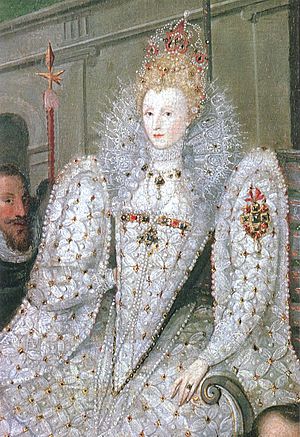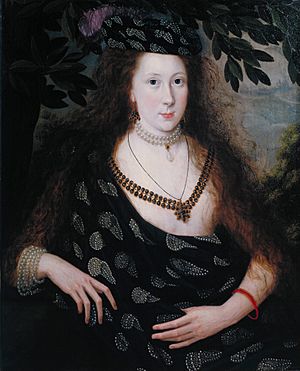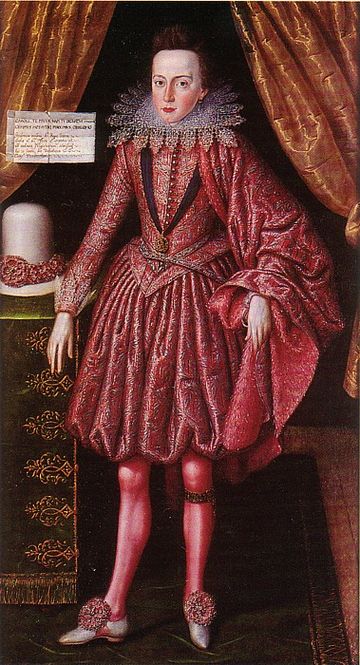Robert Peake the Elder facts for kids
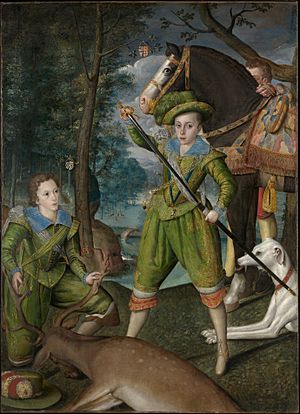
Robert Peake the Elder (around 1551–1619) was an English painter. He worked during the reigns of Queen Elizabeth I and King James I. In 1604, he became the official painter for Prince Henry, who was next in line to the throne. Later, in 1607, he became a "serjeant-painter" for King James I. He shared this important job with another artist named John de Critz.
Peake was the only English painter among a group of four famous artists. The others were John De Critz, Marcus Gheeraerts the Younger, and Isaac Oliver, who painted tiny portraits called miniatures. From 1590 to about 1625, these artists were known for their bright, full-length portraits. These paintings showed people in fancy clothes and were special to England at that time. It can sometimes be hard to tell which artist painted which work, as they often worked together.
Contents
Peake's Family of Artists
Robert Peake married Elizabeth Beckwith around 1579. He is called "the elder" to tell him apart from his son, William Peake (around 1580–1639). William was also a painter and sold prints. Robert's grandson, Sir Robert Peake (around 1605–1667), continued the family print-selling business.
When Prince Henry died, records called Robert Peake "Mr Peake the elder painter." His son William was called "Mr Peake the younger painter." Robert's grandson, Sir Robert Peake, was made a knight by King Charles I. He was captured by Parliament's army during the English Civil War.
Robert Peake's Painting Career
How Peake Started as a Painter
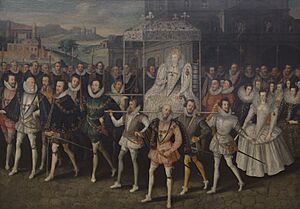
Robert Peake was born in Lincolnshire around 1551. He began his training on April 30, 1565. He learned from Laurence Woodham in London. Peake trained with the Goldsmiths' Company. This was the same company that the famous miniature painter Nicholas Hilliard joined three years earlier. Peake became a full member of the company in 1576. His son William also became a member and a portrait painter.
Peake first appears in records as a painter in 1576. He was paid by the Office of the Revels. This office managed court parties for Queen Elizabeth I. It's not clear when he started painting portraits. But by the late 1580s, he was a "well-known" artist in London. He had many important clients. Records show he was paid for portraits in the 1590s. A signed portrait from 1593, called the "Military Commander," shows his early style.
Peake Becomes the Prince's Painter

In 1607, after another painter named Leonard Fryer died, Peake became a "serjeant-painter" to King James I. He shared this job with John De Critz. This role meant painting new portraits and making copies of them. These copies were given as gifts or sent to other countries. Serjeant-painters also copied and fixed old paintings in the royal collection.
Besides portraits, serjeant-painters also did decorative work. This included painting banners and stage sets. Records show that De Critz managed decorating royal homes. Peake's work isn't listed there. This suggests De Critz handled decorations. Peake likely focused on royal portraits. However, Peake did help paint the ship Prince Royal in 1611.
By 1610, Peake was known as "painter to Prince Henry." Prince Henry was 16 years old and had many artists and thinkers around him. Peake even ordered a translation of a book on architecture. He dedicated it to the prince in 1611. Experts believe Peake's job as Prince Henry's painter led to him becoming the king's serjeant-painter.
Prince Henry's records show payments to "Mr Peck." On October 14, 1608, Peake was paid £7 for "pictures made by His Highness’ command." On July 14, 1609, he got £3 "for a picture of His Highness." This picture was traded for a painting of the King. The records also show the prince spent more on tennis balls than on paintings!
Peake is also listed in records from October 1, 1610, to November 6, 1612. This was when Prince Henry died at 18, possibly from typhoid fever. Peake received £12 for "pictures and frames." He got £50 for "two great pictures of the Prince in arms" sent overseas. He also received £20.4s.0d for "washing, scouring and dressing of pictures and making of frames."
At Henry's funeral, Robert Peake was listed as "Mr Peake the elder painter." He received seven yards of mourning cloth. His son, William Peake, was listed as "Mr Peake the younger painter" and got four yards of cloth.
After Prince Henry's death, Peake worked for Henry's brother, Charles. Charles later became King Charles I. Records from 1616 show Peake was paid £35 for "three different pictures of his Highness." On July 10, 1613, he received £13.6s.8d from Cambridge University. This was for a full-length portrait of Prince Charles. This painting is still at the Cambridge University Library.
When Robert Peake Died
Peake died in October 1619. His will shows this. For a long time, people thought he died later. But his will was made on October 10, 1619, and approved on October 16.
We don't know the exact date of his burial. The church records were lost in the Great Fire of London. Many artists died around this time. Nicholas Hilliard died in January 1619. Anne of Denmark, who supported many artists, died in March. The painter William Larkin, Peake's neighbor, died in April or May. Even though James I ruled until 1625, some historians say 1619 marks the end of "Jacobean painting."
Robert Peake's Famous Paintings
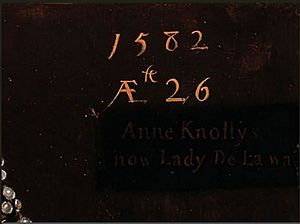
It's hard to know for sure who painted portraits from this time. Artists rarely signed their work. Their workshops often made many copies using the same patterns. However, some paintings are linked to Peake. This is because of how he wrote the year and the person's age on his known portrait of a "military commander" from 1592. It says: "M.BY.RO.| PEAKE" (meaning "made by Robert Peake").
The Procession Picture
The painting called Queen Elizabeth going in procession to Blackfriars in 1601, or The Procession Picture, is now thought to be by Peake. One art historian called it "one of the great visual mysteries." It shows Queen Elizabeth as much younger and more powerful than she was. This was a common way to paint her later in her reign. It shows her as "Gloriana," a queen presenting herself grandly to her people.
This procession was for the wedding of Lord Herbert and Lady Anne Russell in 1600. Many people in the painting have been identified. Queen Elizabeth is not in a litter, but in a wheeled cart. The castles and landscape in the background are not real places. They are symbols of the Welsh lands belonging to the Earl of Worcester. The Earl might have ordered the painting to celebrate his new job in 1601.
Peake did not paint the queen or her courtiers from real life. He used "types" or standard portraits from workshops. There were rules about how to paint the queen. After about 1594, she was always shown as youthful. The famous Ditchley portrait (around 1592) by Marcus Gheeraerts the Younger was used as a pattern. This "Mask of Youth" face was used for the rest of her reign. The queen's face in the procession picture clearly comes from Gheeraerts' portrait. Other figures also look like they were traced from patterns. This sometimes made the perspective look a bit off.

Full-Length Portraits
In the early 1590s, full-length portraits became popular. Wealthy people started adding galleries of these paintings to their homes. Peake was one of the artists who met this demand. He was also one of the first English painters to show people in full length, sometimes in outdoor settings. This style became popular in England. As the main painter for Prince Henry, Peake often showed him as a brave young warrior.
In 1603, Peake painted a double portrait. It shows Prince Henry and his friend John Harington. This painting is now in the Metropolitan Museum in New York. The painting is set outdoors, a style that became popular in the 1590s. Peake's mix of people, animals, and landscape also hints at future "sporting pictures." The outdoor setting makes the painting feel relaxed. The scene shows a deer park with a castle in the distance. Harington holds a wounded deer. Henry is about to use his sword to finish the hunt. The prince wears a jewel of St George slaying the dragon. This shows his role as a protector. His sword is a symbol of kingship. The young noble kneels to serve him. The deer is a fallow deer, a type kept for hunting in royal parks. Another version of this painting, from around 1605, shows Robert Devereux, 3rd Earl of Essex, instead of John Harington.
In the same year, Peake also painted Elizabeth, King James I's only daughter. This painting might have been a companion to the double portrait. It was likely painted for the Harington family, who cared for Elizabeth from 1603 to 1608. In the background of Elizabeth's portrait, there is a hunting scene. Two ladies sit on a small hill, a popular garden design at the time.
Peake painted Henry outdoors again around 1610. In this portrait, now in Italy, the prince looks almost the same age as in the 1603 painting. But his left foot rests on a shield with the three-feather symbol of the Prince of Wales. He did not get this title until 1610. Henry is shown as an active young man. He is about to draw a sword decorated with jewels. This portrait was likely sent to Savoy. This was for a possible marriage between Henry and a princess there in 1611.
King James I's daughter Elizabeth was also important for marriage alliances. She was offered to Savoy as a bride for the Prince of Piedmont. Exchanging portraits was common for royal marriage proposals. This gave royal painters a lot of work. Prince Henry ordered portraits from Peake to send to different countries. For example, two portraits Peake painted of him in armor in 1611–12 were "sent beyond the seas."
A painting from this time shows the prince in armor. He is on a white horse. He is pulling the winged figure of Father Time by his hair. This means taking an opportunity. The old man carries Henry's spear and helmet. One expert points out that the old man's pose is like a figure in a famous old drawing. When the painting was cleaned in 1985, the old man and a wall behind him were seen for the first time. They had been painted over in the 1600s. The painting has also been cut down.
Lady Elizabeth Pope's Portrait
Peake's portrait of Lady Elizabeth Pope might have been ordered by her husband, Sir William Pope. It may have celebrated their marriage in 1615. Lady Elizabeth is shown with her hair down. This was a symbol of a bride's purity. She wears a draped cloak with pearl feathers and a matching turban. This type of cloak was worn in court plays called masques. Loose hair and draped cloaks were also used to show ideas in paintings. One historian thinks Peake might be showing Lady Elizabeth as a symbol of America. This is because her father was a major investor in the Virginia Company.
How Good Was Peake's Art?
In 1598, a writer named Francis Meres listed Peake as one of the best English artists. In 1612, Henry Peacham wrote that his "good friend Mr Peake" was excellent at oil painting. One art historian said that these fancy costume paintings were like decorative art. He noted that their "bright shine" is unique in European art. They were mainly made by the workshops of Peake, Gheeraerts the Younger, and De Critz. Peake's work shows the influence of Hilliard's bright miniatures. He used styles from European Mannerism. By the time he became serjeant-painter in 1607, his style was a bit old-fashioned. However, Peake's portraits of Prince Henry were the first to show him in "action" poses.
Some experts believe Peake's creativity became less strong over time. They say his talent was "dampened by mass production." They describe his Cambridge portrait of Prince Charles, as Duke of York as poorly drawn. They say the pose is lifeless and the composition is too common. However, another art historian, Karen Hearn, calls the work "magnificent." She points out the realistic note pinned to the curtain. Peake painted this portrait for Charles's visit to Cambridge in 1613. Charles received a master's degree there. The portrait shows Prince Charles wearing the Garter and Lesser George. Peake used a more formal style here. The note on the curtain, which looks real, celebrates Charles's visit in Latin. X-rays of the painting show that Peake painted it over another portrait. You can see signs that he changed it. For example, Charles's right hand was originally on his waist.
Images for kids
-
Portrait of Anne Knollys, 1582.
-
Frances Walsingham, Countess of Essex, and her son Robert, later 3rd Earl of Essex, 1594.
-
After Prince Henry's death in 1612, Peake worked for his brother, the future Charles I. Here, Charles is shown in the robes of the Order of the Garter, around 1611–12.
See also


